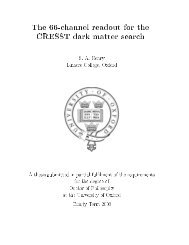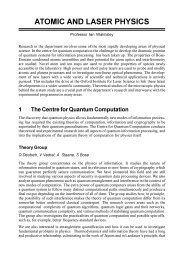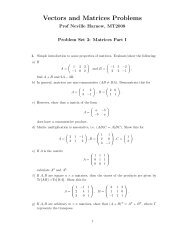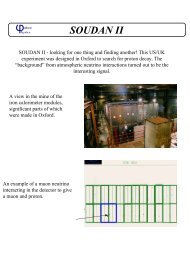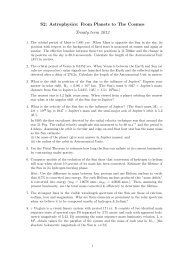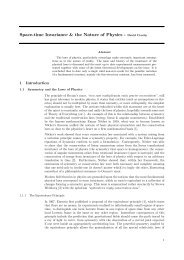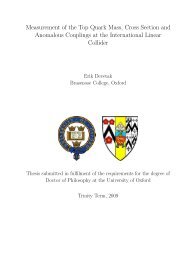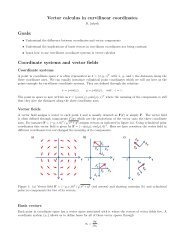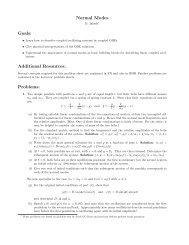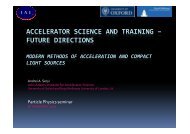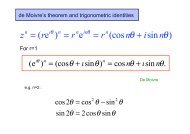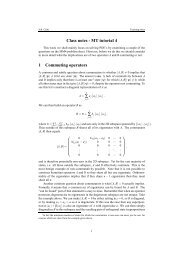You also want an ePaper? Increase the reach of your titles
YUMPU automatically turns print PDFs into web optimized ePapers that Google loves.
Carnot Cycle (Ideal Cycle)<br />
T<br />
Q 12<br />
T 1 2<br />
a<br />
W 41<br />
W 23<br />
Q 34<br />
T b<br />
4 3<br />
S<br />
1) Heat absorption at constant<br />
temperature, T a (boiler) 12<br />
2) Isentropic expansion work<br />
output (turbine) 23<br />
3) Heat rejection at constant<br />
temperature, T b (condenser) 34<br />
4) Isentropic compression<br />
(pump) 41<br />
Energy Conservation (1 st Law <strong>of</strong> Thermodynamics)<br />
Q 12 + W 23 + Q 34 + W 41 = 0<br />
(Note: Q 12<br />
> 0, W 23<br />
< 0, Q 34<br />
< 0, W 41<br />
> 0)<br />
Cycle efficiency, η c = (Useful work out)/(Heat input at T a )<br />
ie η c = (| W 23 | − W 41 )/ Q 12 | = (T a − T b )/ T a = 1 − T b / T a<br />
(Note: T measured in K (absolute temperature) – formal<br />
definition <strong>of</strong> absolute temperature scale)<br />
Practical difficulties in using a Carnot Cycle<br />
1) Boiler operates only in wet-steam regime otherwise temperature<br />
would rise when all the <strong>water</strong> has turned to steam, violating<br />
condition for Carnot Cycle<br />
turbine expands wet steam<br />
<strong>water</strong> droplets hit turbine blades (damage)<br />
2) Maximum temperature (T a ) is limited to ~650 K<br />
efficiency <strong>of</strong> cycle is severely constrained<br />
3) Compression <strong>of</strong> <strong>water</strong>/steam mixture is thermodynamically<br />
unstable (<strong>water</strong> droplets)<br />
very large volume compressor (expensive)<br />
Rankine Cycle overcomes all these problems<br />
T<br />
2b<br />
2a<br />
T b<br />
1b 1a<br />
2c<br />
S<br />
Rankine Cycle<br />
Step 1:<br />
a) Condense all the steam to <strong>water</strong><br />
in the condenser<br />
b) Pumping <strong>water</strong> to high pressure requires<br />
small volume machine and little energy<br />
T<br />
T b<br />
T a<br />
S<br />
Step 3:<br />
Expand dry steam through a turbine<br />
to generate shaft power<br />
In practice, <strong>water</strong> droplets still form in<br />
the low pressure end <strong>of</strong> the turbine, so<br />
the steam is reheated at various stages<br />
Step 2:<br />
Use 3-stage boiler (~ constant pressure)<br />
a) Economiser – <strong>water</strong> heated at constant pressure<br />
b) Evaporator – <strong>water</strong>/steam mixture heated at constant pressure<br />
c) Superheater – dry steam heated at constant pressure<br />
[Note that there is a small drop in pressure through the boiler tube<br />
in order to overcome frictional losses]<br />
T<br />
T a<br />
T b<br />
S<br />
HP<br />
from<br />
IP LP<br />
boiler<br />
reheaters<br />
HP: high pressure turbine<br />
IP: intermediate pressure turbine<br />
LP: low pressure turbine<br />
to condenser




